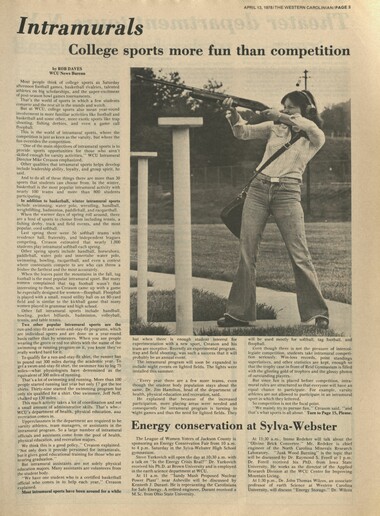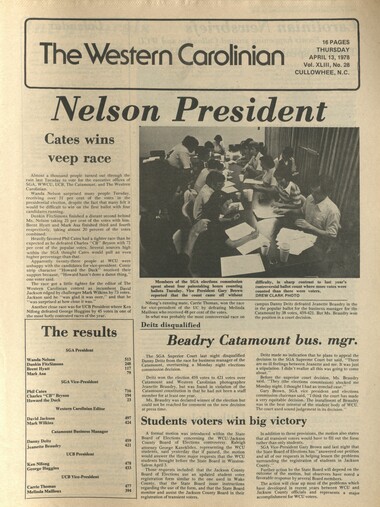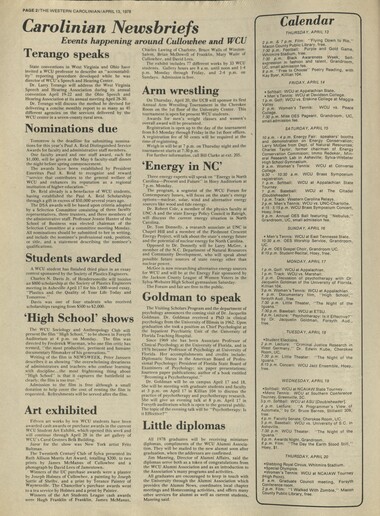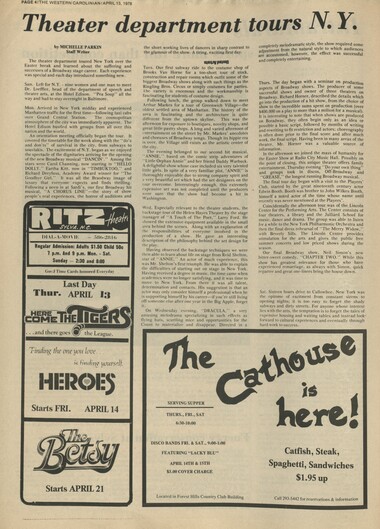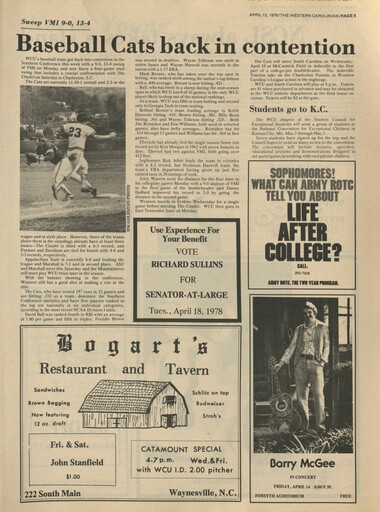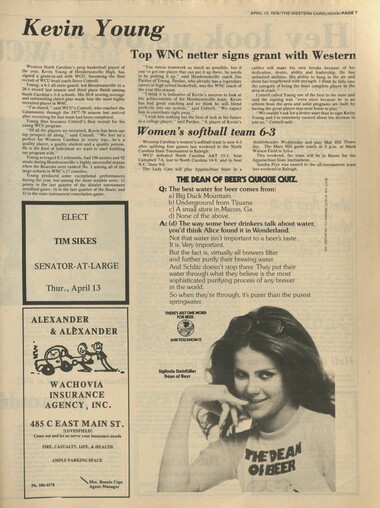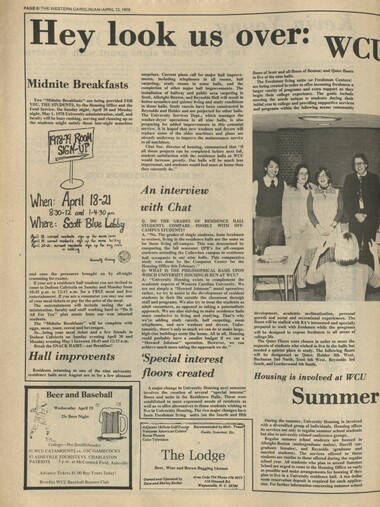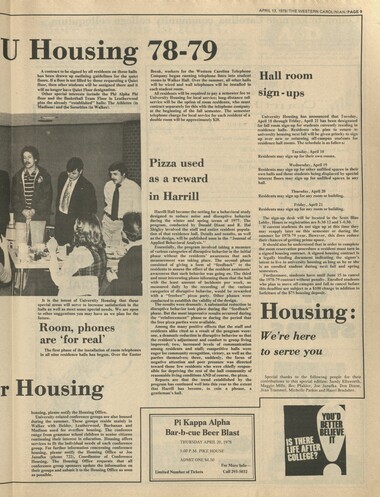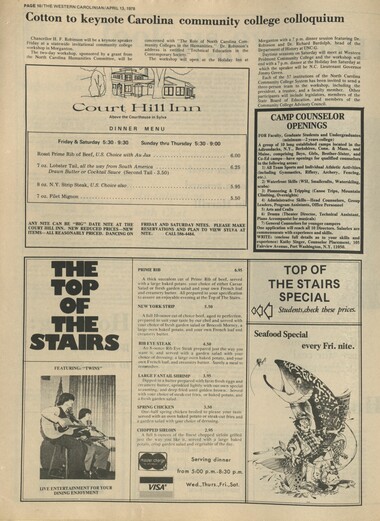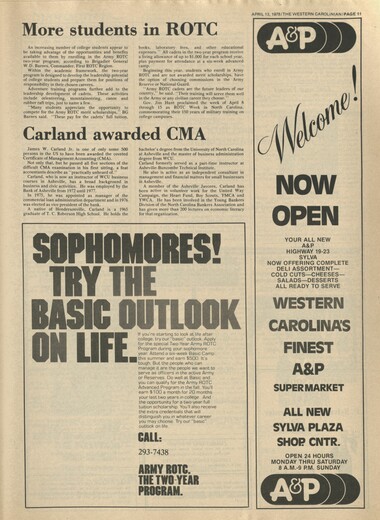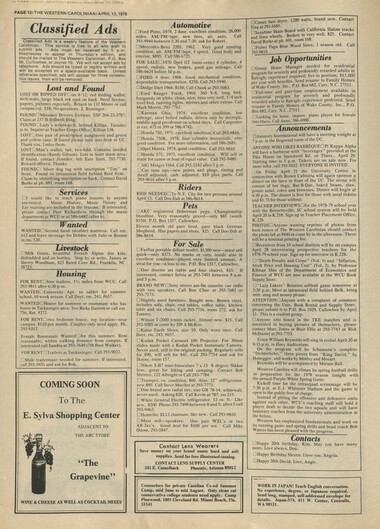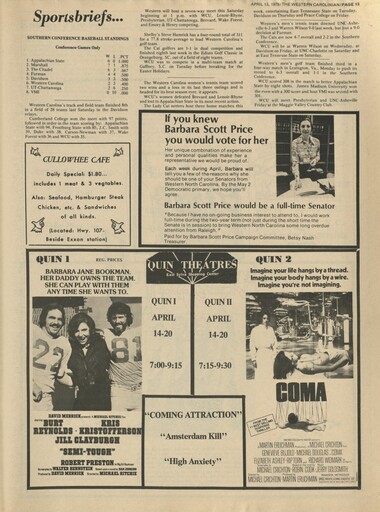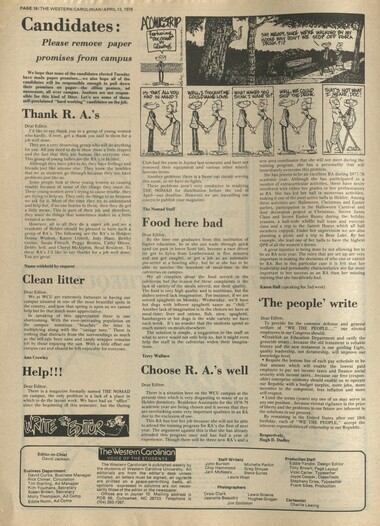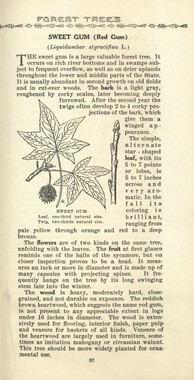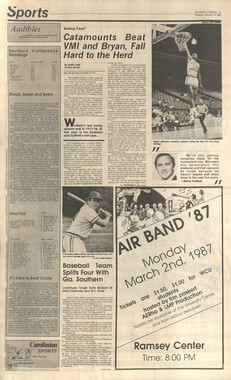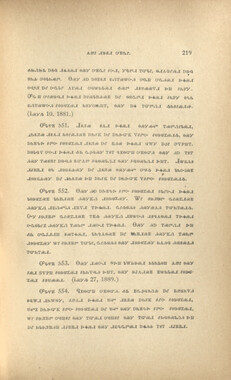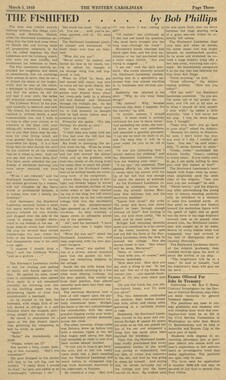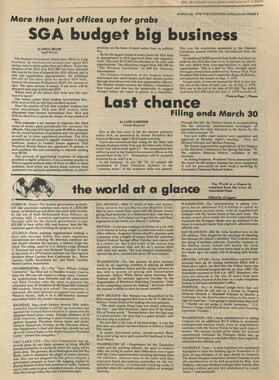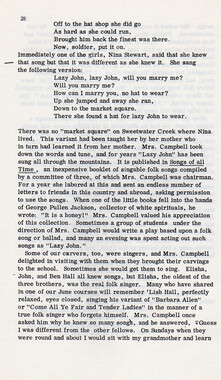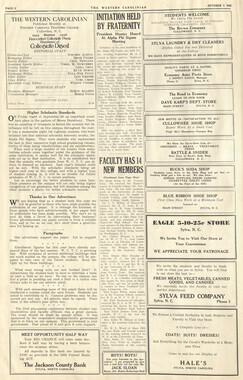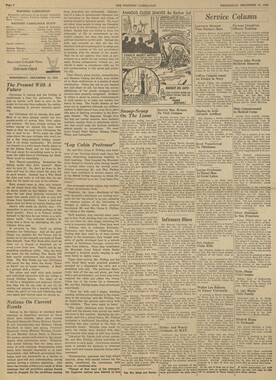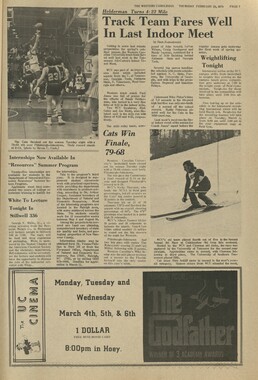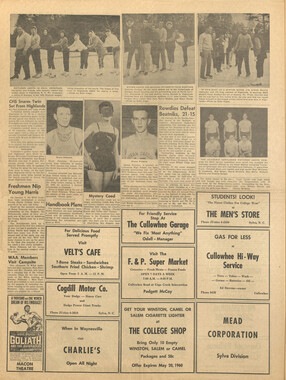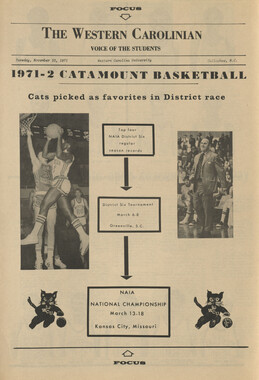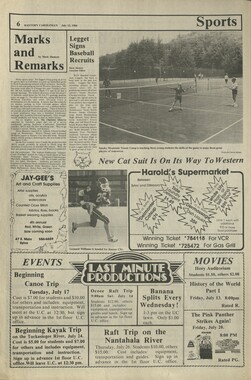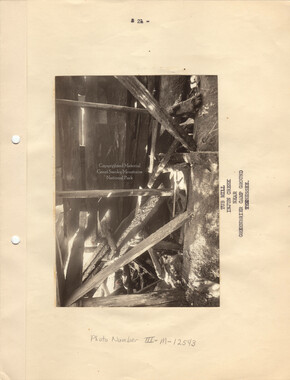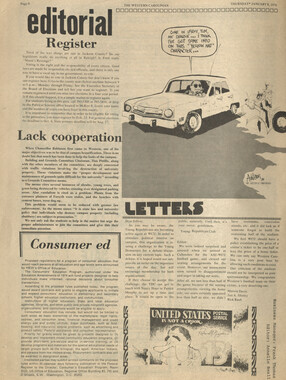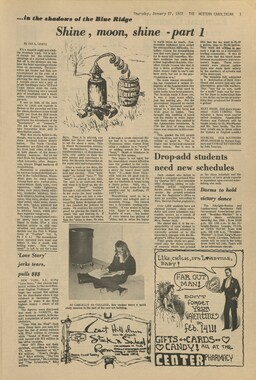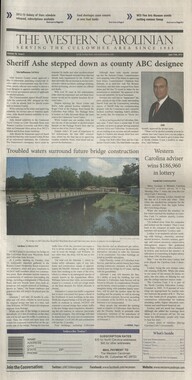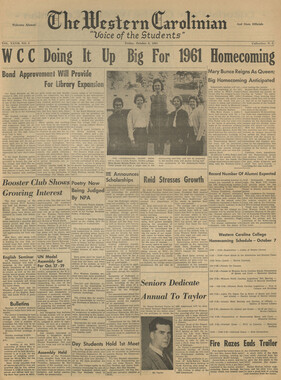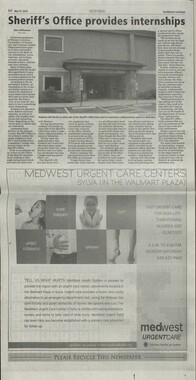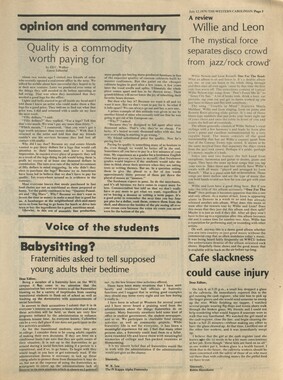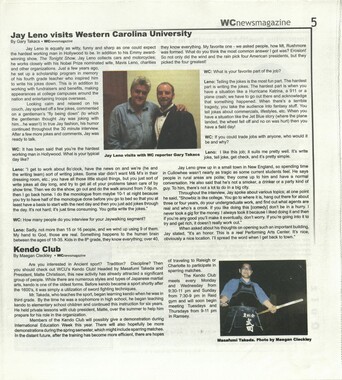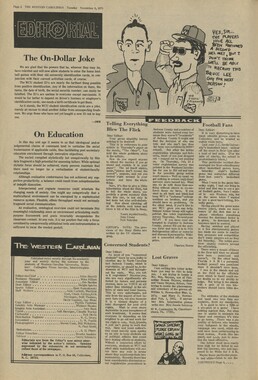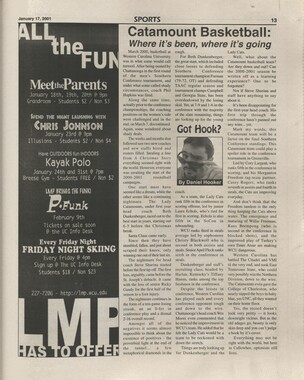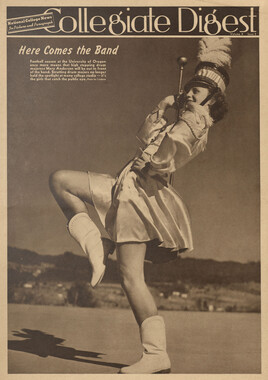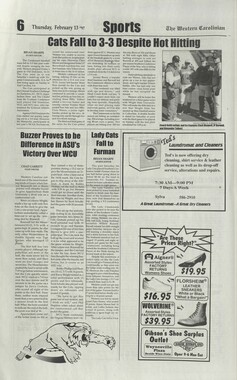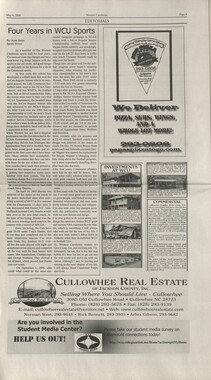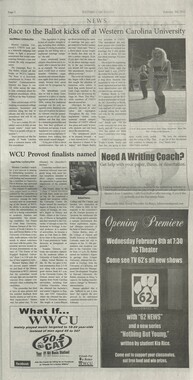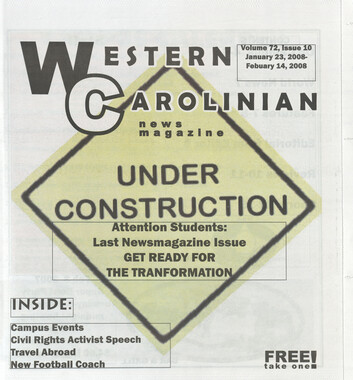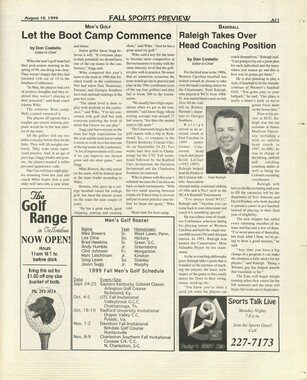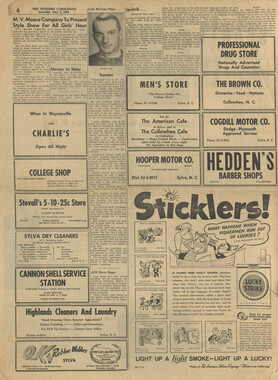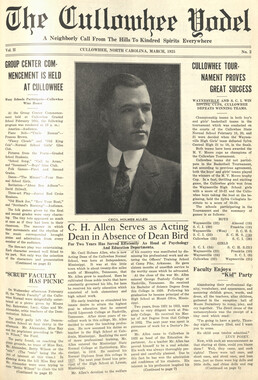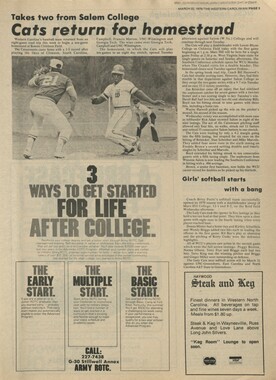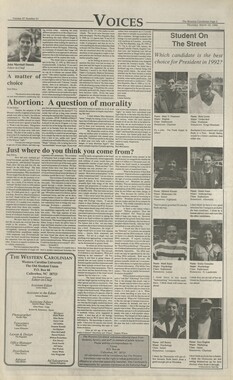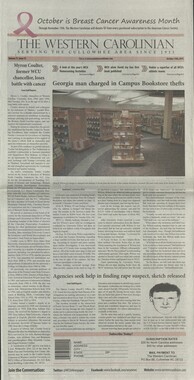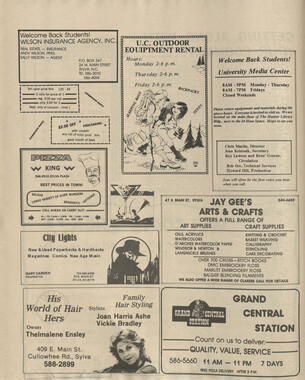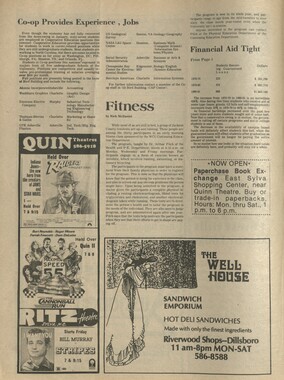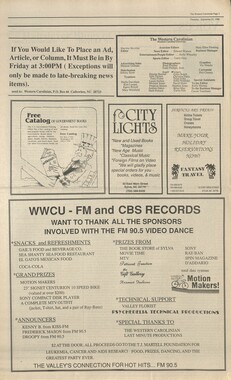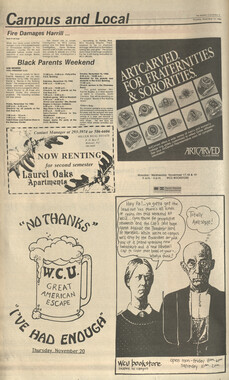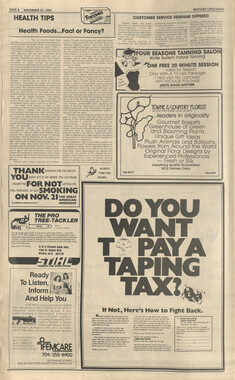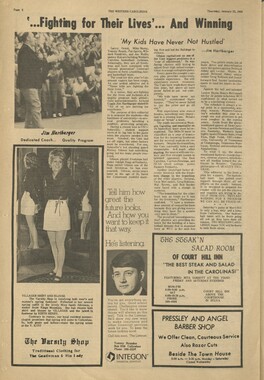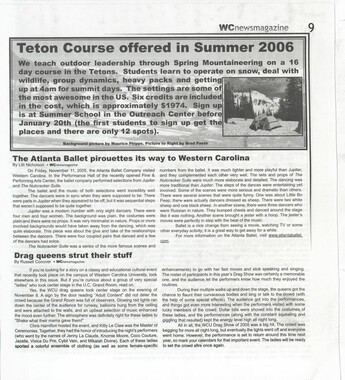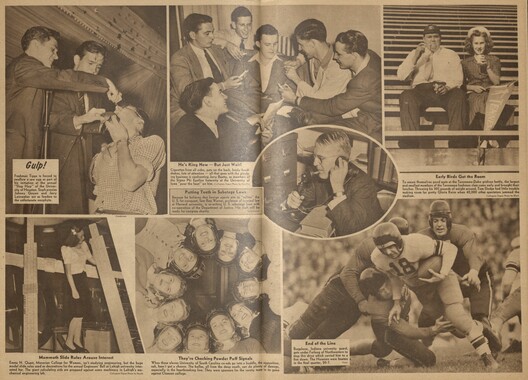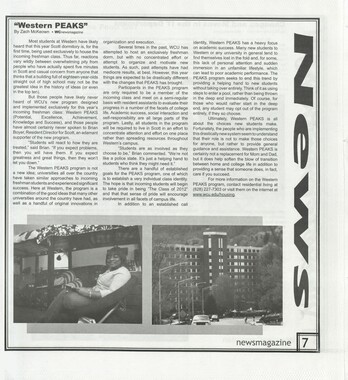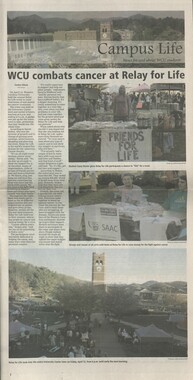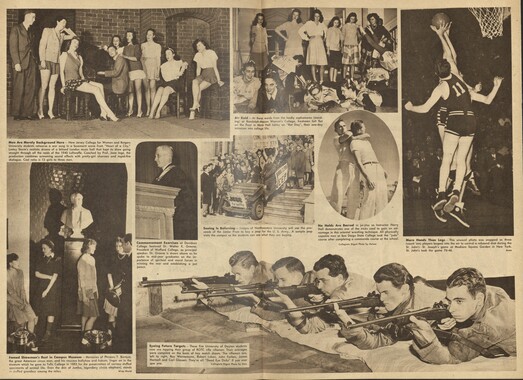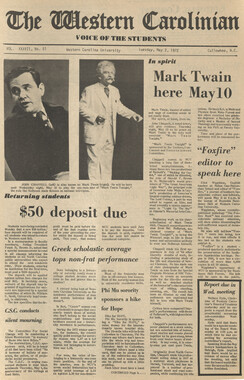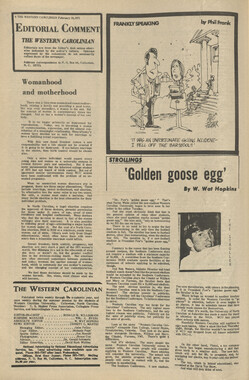Western Carolina University (21)
View all
- Canton Champion Fibre Company (2308)
- Cherokee Traditions (291)
- Civil War in Southern Appalachia (165)
- Craft Revival (1942)
- George Masa Collection (137)
- Great Smoky Mountains - A Park for America (3182)
- Highlights from Western Carolina University (422)
- Horace Kephart (998)
- Journeys Through Jackson (159)
- LGBTQIA+ Archive of Jackson County (90)
- Oral Histories of Western North Carolina (318)
- Picturing Appalachia (6617)
- Stories of Mountain Folk (413)
- Travel Western North Carolina (153)
- Western Carolina University Fine Art Museum Vitreograph Collection (129)
- Western Carolina University Herbarium (92)
- Western Carolina University: Making Memories (738)
- Western Carolina University Publications (2491)
- Western Carolina University Restricted Electronic Theses and Dissertations (146)
- Western North Carolina Regional Maps (71)
- World War II in Southern Appalachia (131)
University of North Carolina Asheville (6)
View all
- Allanstand Cottage Industries (62)
- Appalachian National Park Association (53)
- Bennett, Kelly, 1890-1974 (1463)
- Berry, Walter (76)
- Brasstown Carvers (40)
- Carver, George Washington, 1864?-1943 (26)
- Cathey, Joseph, 1803-1874 (1)
- Champion Fibre Company (233)
- Champion Paper and Fibre Company (297)
- Cherokee Indian Fair Association (16)
- Cherokee Language Program (22)
- Crowe, Amanda (40)
- Edmonston, Thomas Benton, 1842-1907 (7)
- Ensley, A. L. (Abraham Lincoln), 1865-1948 (275)
- Fromer, Irving Rhodes, 1913-1994 (70)
- George Butz (BFS 1907) (46)
- Goodrich, Frances Louisa (120)
- Grant, George Alexander, 1891-1964 (96)
- Heard, Marian Gladys (60)
- Kephart, Calvin, 1883-1969 (15)
- Kephart, Horace, 1862-1931 (313)
- Kephart, Laura, 1862-1954 (91)
- Laney, Gideon Thomas, 1889-1976 (439)
- Masa, George, 1881-1933 (61)
- McElhinney, William Julian, 1896-1953 (44)
- Niggli, Josephina, 1910-1983 (10)
- North Carolina Park Commission (105)
- Osborne, Kezia Stradley (9)
- Owens, Samuel Robert, 1918-1995 (11)
- Penland Weavers and Potters (36)
- Roberts, Vivienne (15)
- Roth, Albert, 1890-1974 (142)
- Schenck, Carl Alwin, 1868-1955 (1)
- Sherrill's Photography Studio (2565)
- Southern Highland Handicraft Guild (127)
- Southern Highlanders, Inc. (71)
- Stalcup, Jesse Bryson (46)
- Stearns, I. K. (213)
- Thompson, James Edward, 1880-1976 (226)
- United States. Indian Arts and Crafts Board (130)
- USFS (683)
- Vance, Zebulon Baird, 1830-1894 (1)
- Weaver, Zebulon, 1872-1948 (58)
- Western Carolina College (230)
- Western Carolina Teachers College (282)
- Western Carolina University (2008)
- Western Carolina University. Mountain Heritage Center (18)
- Whitman, Walt, 1819-1892 (10)
- Wilburn, Hiram Coleman, 1880-1967 (73)
- Williams, Isadora (3)
- Cain, Doreyl Ammons (0)
- Crittenden, Lorraine (0)
- Rhodes, Judy (0)
- Smith, Edward Clark (0)
- Appalachian Region, Southern (3032)
- Asheville (N.C.) (1945)
- Avery County (N.C.) (26)
- Blount County (Tenn.) (200)
- Buncombe County (N.C.) (1680)
- Cherokee County (N.C.) (283)
- Clay County (N.C.) (556)
- Graham County (N.C.) (247)
- Great Smoky Mountains National Park (N.C. and Tenn.) (535)
- Haywood County (N.C.) (3573)
- Henderson County (N.C.) (70)
- Jackson County (N.C.) (4926)
- Knox County (Tenn.) (61)
- Knoxville (Tenn.) (21)
- Lake Santeetlah (N.C.) (14)
- Macon County (N.C.) (421)
- Madison County (N.C.) (216)
- McDowell County (N.C.) (39)
- Mitchell County (N.C.) (135)
- Polk County (N.C.) (35)
- Qualla Boundary (982)
- Rutherford County (N.C.) (78)
- Swain County (N.C.) (2187)
- Transylvania County (N.C.) (270)
- Watauga County (N.C.) (12)
- Waynesville (N.C.) (86)
- Yancey County (N.C.) (72)
- Aerial Photographs (3)
- Aerial Views (60)
- Albums (books) (4)
- Articles (1)
- Artifacts (object Genre) (228)
- Bibliographies (1)
- Biography (general Genre) (2)
- Cards (information Artifacts) (38)
- Clippings (information Artifacts) (193)
- Copybooks (instructional Materials) (3)
- Crafts (art Genres) (622)
- Depictions (visual Works) (21)
- Design Drawings (1)
- Digital Moving Image Formats (2)
- Drawings (visual Works) (185)
- Envelopes (115)
- Exhibitions (events) (1)
- Facsimiles (reproductions) (1)
- Fiction (general Genre) (4)
- Financial Records (12)
- Fliers (printed Matter) (67)
- Glass Plate Negatives (381)
- Guidebooks (2)
- Internegatives (10)
- Interviews (823)
- Land Surveys (102)
- Letters (correspondence) (1070)
- Manuscripts (documents) (618)
- Maps (documents) (177)
- Memorandums (25)
- Minutes (administrative Records) (59)
- Negatives (photographs) (6192)
- Newsletters (1290)
- Newspapers (2)
- Notebooks (8)
- Occupation Currency (1)
- Paintings (visual Works) (1)
- Pen And Ink Drawings (1)
- Periodicals (194)
- Personal Narratives (10)
- Photographs (12977)
- Plans (maps) (1)
- Poetry (6)
- Portraits (4573)
- Postcards (329)
- Programs (documents) (181)
- Publications (documents) (2444)
- Questionnaires (65)
- Relief Prints (26)
- Sayings (literary Genre) (1)
- Scrapbooks (282)
- Sheet Music (2)
- Slides (photographs) (402)
- Songs (musical Compositions) (2)
- Sound Recordings (802)
- Specimens (92)
- Speeches (documents) (18)
- Tintypes (photographs) (8)
- Transcripts (329)
- Text Messages (0)
- A.L. Ensley Collection (275)
- Appalachian Industrial School Records (7)
- Appalachian National Park Association Records (336)
- Axley-Meroney Collection (2)
- Bayard Wootten Photograph Collection (20)
- Bethel Rural Community Organization Collection (7)
- Blumer Collection (5)
- C.W. Slagle Collection (20)
- Canton Area Historical Museum (2110)
- Carlos C. Campbell Collection (564)
- Cataloochee History Project (64)
- Cherokee Studies Collection (4)
- Daisy Dame Photograph Album (5)
- Daniel Boone VI Collection (1)
- Doris Ulmann Photograph Collection (112)
- Elizabeth H. Lasley Collection (1)
- Elizabeth Woolworth Szold Fleharty Collection (4)
- Frank Fry Collection (95)
- George Masa Collection (173)
- Gideon Laney Collection (452)
- Hazel Scarborough Collection (2)
- Hiram C. Wilburn Papers (28)
- Historic Photographs Collection (236)
- Horace Kephart Collection (861)
- Humbard Collection (33)
- Hunter and Weaver Families Collection (1)
- I. D. Blumenthal Collection (4)
- Isadora Williams Collection (4)
- Jesse Bryson Stalcup Collection (47)
- Jim Thompson Collection (224)
- John B. Battle Collection (7)
- John C. Campbell Folk School Records (80)
- John Parris Collection (6)
- Judaculla Rock project (2)
- Kelly Bennett Collection (1482)
- Love Family Papers (11)
- Major Wiley Parris Civil War Letters (3)
- Map Collection (12)
- McFee-Misemer Civil War Letters (34)
- Mountain Heritage Center Collection (4)
- Norburn - Robertson - Thomson Families Collection (44)
- Pauline Hood Collection (7)
- Pre-Guild Collection (2)
- Qualla Arts and Crafts Mutual Collection (12)
- R.A. Romanes Collection (681)
- Rosser H. Taylor Collection (1)
- Samuel Robert Owens Collection (94)
- Sara Madison Collection (144)
- Sherrill Studio Photo Collection (2558)
- Smoky Mountains Hiking Club Collection (616)
- Stories of Mountain Folk - Radio Programs (374)
- The Reporter, Western Carolina University (510)
- Venoy and Elizabeth Reed Collection (16)
- WCU Gender and Sexuality Oral History Project (36)
- WCU Mountain Heritage Center Oral Histories (25)
- WCU Oral History Collection - Mountain People, Mountain Lives (71)
- WCU Students Newspapers Collection (1923)
- Western North Carolina Tomorrow Black Oral History Project (69)
- William Williams Stringfield Collection (2)
- Zebulon Weaver Collection (109)
- African Americans (390)
- Appalachian Trail (35)
- Artisans (521)
- Cherokee art (84)
- Cherokee artists -- North Carolina (10)
- Cherokee language (21)
- Cherokee pottery (101)
- Cherokee women (208)
- Church buildings (190)
- Civilian Conservation Corps (U.S.) (114)
- College student newspapers and periodicals (2012)
- Dams (115)
- Dance (1023)
- Education (222)
- Floods (63)
- Folk music (1015)
- Forced removal, 1813-1903 (2)
- Forest conservation (220)
- Forests and forestry (1198)
- Gender nonconformity (4)
- Great Smoky Mountains National Park (N.C. and Tenn.) (181)
- Hunting (47)
- Landscape photography (25)
- Logging (122)
- Maps (83)
- Mines and mineral resources (9)
- North Carolina -- Maps (18)
- Paper industry (38)
- Postcards (255)
- Pottery (135)
- Railroad trains (72)
- Rural electrification -- North Carolina, Western (3)
- School integration -- Southern States (2)
- Segregation -- North Carolina, Western (5)
- Slavery (5)
- Sports (452)
- Storytelling (243)
- Waterfalls -- Great Smoky Mountains (N.C. and Tenn.) (66)
- Weaving -- Appalachian Region, Southern (280)
- Wood-carving -- Appalachian Region, Southern (328)
- World War, 1939-1945 (174)
Western Carolinian Volume 43 Number 28
Item
Item’s are ‘child’ level descriptions to ‘parent’ objects, (e.g. one page of a whole book).
-
-
APRIL 13, 1978/THE WESTERN CAROLINIAN/PAGE 3 Intramurals College sports more fun than competition by ROB DAVES WCU News Bureau Most people think of college sports as Saturday afternoon football games, basketball rivalries, talented athletes on big scholarships, and the super-excitment ot post-season bowl games tournaments. That's the world of sports in which a few students compete and the rest sit in the stands and watch. But at WCU, college sports also mean year-round involvement in mon- familiar activities like football and basketball and some other, mon- exotic sports like trap shooting, fishing derbies, and even a game call floopball, This is the world of intramural sports, where the competition is just as keen as the varsity, but where the fun overrides the competition. "One of the main objectives of intramural sports is to provide sports opportunities for those who aren't skilled enough for varsity activities," WCU Intramural Director Mike Creason emphasized. Other qualities that intramural sports helps develop include leadership ability, loyalty, and group spirit, he said. And to do all of these things there are more than 30 sports that students can choose from. In the winter, basketball is the most popular intramural activity with nearly 100 teams and more than 800 students participating. In addition to basketball, winter intramural sports include swimming, water polo, wrestling, handball, weightlifting, badminton, paddleball, and racquetball. When the warmer days of spring roll around, there are a host of sports to choose from including tennis, a fishing derby, track and field events, and the most popular, coed softball. Last spring there were 56 softball teams with residence hall, fraternity, and independent leagues competing. Creason estimated that nearly 1,000 students play intramural softball each spring. Other spring sports include handball, horseshoes, paddleball, water polo and innertube water polo, swimming, bowling, racquetball, and even a contest where contestants compete to see who can throw a frisbee the farthest and the most accurately. When the leaves paint the mountains in the fall, tag football is the most popular intramural sport. But many women complained that tag football wasn't that interesting to them, so Creason came up with a game he especially designed for women—floopball. Floopball is played with a small, round utility ball on an 80-yard field and is similar to the kickball game that many women played in grammar and high school. Other fall intramural sports include handball, bowling, pocket billiards, badminton, volleyball, tennis, and table tennis. Two other popular intramural sports are the run-and-stay-fit and swim-and-stay-fit programs, which are individual sports and are done on a year-round basis rather than by semesters. When you see people wearing the green or red tee shirts with the name of the swimming or running program on it, you know they've really worked hard for it. To qualify for a run-and-stay-fit shirt, the runner has to pound out 300 miles during the academic year. To get a swim-and-stay-fit shirt, the swimmer has to log 75 miles—what physiologists have determined as the equivalent of 300 miles of running. That's a lot of swimming and running. More than 100 people started running last year but only 17 got the tee shirts. Thirty-nine started the swimming program but only six qualified for a shirt. One swimmer, Jeff Neff, chalked up 130 miles. This much activity takes a lot of coordination and not a small amount of administrative skills. That's whe,i WCU's department of health, physical education, ana recreation comes in. Upperclassmen in the department are required to be varsity athletes, team managers, or assistants in the intramural program. So a large number of intramural officials and assistants come from the pool of health, physical education, and recreation majors. We think this is a good policy," Creason explained. "Not only does it provide personnel for intramurals, but it gives good educational training for those who are nearing graduation." But intramural assistants are not solely physical education majors. Many assistants are volunteers from the student body. "We have one student who is a certified basketball official who comes in to help each year," Creason explained. Most intramural sports have been around for a while but when there is enough student interest for experimentation with a new sport, Creason and his team are receptive. Recently an experimental program, trap and field shooting, was such a success that it will probably be an annual event. The intramural program will soon be expanded to include night events on lighted fields. The lights were installed this summer. "Every year there are a few more teams, even though the student body population stays about the same. Dr. Jim Hamilton, head of the department of health, physical education and recreation, said. He explained that because of the increased participation, more playing areas were needed and consequently the intramural program is turning to flight games and thus the need for lighted fields. They will be used mostly for softball, tag football, and floopball. Even though there is not the pressure of intercollegiate competition, students take intramural competition seriously. Win-loss records, point standings superlatives, and other statistics are kept, enough so that the trophy case in front of Reid Gymnasium is filled with the glinting gold of trophies and the glossy photos of outstanding players. But since fun is placed before competition, intramural rules are structured so that everyone will have an equal chance to participate. For example, varsity- athletes are not allowed to participate in an intramural sport in which they lettered. So competition is not the focal point. "We mainly try to pursue fun." Creason said, "and that's what sports is all about.' Turn to Page 15> Please. Energy conservation at Sylva-Webster The League of Women Voters of Jackson County is sponsoring an Energy Conservation Fair from 10 a.m. to 4 p.m. Saturday in the Sylva-Webster High School gymnasium. Steve Yurkovich will open the day at 10:30 a.m. with a talk on "Is the Energy Crisis Real?" Dr. Yurkovich received his Ph.D. at Brown University and is employed in the earth science department at WCU. At 11 a.m. the "Sandy Mush Proposed Nuclear Power Plant" near Asheville will be discussed by Kenneth J. Durant. He is representing the Carolinians for Safe Energy. A retired engineer, Durant received a M.Sc. from Ohio State University. At 11:30 a.m., Immo Redeker will talk about the "Olivine Brick Converter." Mr. Redeker is chief engineer of the North Carolina Minerals Research Laboratory. "Junk Wood Burning" is the topic that will be discussed by Dr. Raymond S. Ferell at 1 p.m. Dr. Ferell received his PhD. from Iowa State University. He works as the director of the Applied Research Division at the WCU Center for Improving Mountain Living. At 1:30 p.m., Dr. John Thomas Wilcox, an associate professor of earth Science at Western Carolina University, will discuss "Energy Storage." Dr. Wilcox
Object
Object’s are ‘parent’ level descriptions to ‘children’ items, (e.g. a book with pages).
-
The Western Carolinian is Western Carolina University’s student-run newspaper. The paper was published as the Cullowhee Yodel from 1924 to 1931 before changing its name to The Western Carolinian in 1933.
-
